The Thermaltake Toughpower GF3 with 1650W max power is currently the strongest ATX v3.0 and PCIe 5.0 ready power supply. You won’t need more power, even with a highly overclocked NVIDIA RTX 4090 and a power hungry CPU combo. This PSU can cope with up to 3300W power spikes! That says it all!
You will already find reviews of Thermaltake’s GF3 models on hwbusters, the 750W, 850W, 1000W, and 1200W, which Channel Well Technology makes. The most recent GF3 review is the one for the 1350W unit. For those who didn’t read it, I should repeat that the two highest capacity GF3 models use a High Power platform. Usually, stronger than 1300W units have at least Platinum efficiency because the power losses increase; hence the fan has to work over hours to cope with the thermal loads. However, Thermaltake decided not to stop at the GF3 1350 but also offer a 300W stronger version, which has the title of the strongest ATX v3.0 and PCIe 5.0 ready PSU.
Even with a super-clocked RTX 4090 and a sky-high clocked CPU, this PSU won’t sweat. It can power two RTX 4090s simultaneously if you have deep pockets to buy them since it comes with two 12VHPWR connectors. This is the first PSU I meet, with a pair of PCIe 12+4 pin connectors. With 180mm depth, I could say that it has a compact footprint, given its max power, and the 300 dollars price tag is fair for a 1650W beast.
The GF3 1350W is among the few high-capacity and Gold efficiency in the 80 PLUS scheme, PSUs. Usually stronger than 1000W, PSUs have Platinum or higher efficiency certifications to restrict thermal loads, which lead to high-speed fan operation and excess noise output. Although the GF3 1350W achieves Platinum efficiency in the Cybenetics scheme, its fan speed profile is tuned aggressively, so if you plan to push this unit hard, I suggest you buy good noise-canceling headphones and warn your neighbors. Since, in most cases, Platinum PSUs are expensive, the sweat spot for Gold units is at 1000W, where some quiet operating PSUs can be found. Take a look at the Cybenetics database before you proceed with a new PSU purchase, especially if you want to get a silent operating one.
- Manufacturer (OEM): High Power
- Max Power: 1650W
- Cybenetics Efficiency: [115V] Cybenetics Platinum (89-91%)
- 80 Plus Efficiency: Gold
- Noise: Above 45 dBA, so it doesn’t get a Cybenetics rating
- Compliance: ATX12V v3.0, EPS 2.92
- Alternative Low Power Mode support: Yes
- Power 12V: 1650W
- Power 5V + 3.3V: 130W
- Power 5VSB: 15W
- Cooling: 140mm Hydraulic Bearing Fan [TT-1425 (A1425S12S-2)]
- Semi-Passive Operation: Yes (Selectable)
- Modular Design: Yes (Fully)
- High Power Connectors: 2x EPS (2x cables), 9x PCIe 6+2 pin (6x cables), 2x PCIe 12+4 pin (600W)
- Peripheral Connectors: 16x SATA (4x cables), 8x 4-pin Molex (2x cables), 1x FDD adapter
- ATX/EPS Cable Length: 600/750mm
- Distance between SATA / 4-pin Molex connectors: 150mm
- In-cable capacitors: No
- Dimensions (W x H x D): 150 mm x 85 mm x 180 mm
- Weight: 2.2 kg (4.85 lb)
- Warranty: 10 years
Box & Bundle
The box is identical to the 1350W unit, with only the capacity description and the PSU photo changed at its face. The ATX v3.0 and PCIe 5.0 compatibility is also highlighted, along with the fan-stop feature, the Japanese capacitors, and the ten-year warranty. Inside the box, the protection is adequate, and the bundle is rich enough, including a pouch for storing the unused modular cables. With the vast amount of modular cables provided, you will surely need it.
Product Photos
A few years ago, 1500-1600W units were much larger, with 220mm depth, but this one only measures 180mm. This means that you won’t need a gigantic chassis to accommodate it. On the other hand, users getting such a strong PSU need it to power many components, which of course, need a large case.
Cables
| Modular Cables | ||||
| Description | Cable Count | Connector Count (Total) | Gauge | In Cable Capacitors |
|---|---|---|---|---|
| ATX connector 20+4 pin (600mm) | 1 | 1 | 16-22AWG | No |
| 8-pin EPS12V (750mm) | 1 | 1 | 16AWG | No |
| 4+4 pin EPS12V (750mm) | 1 | 1 | 16AWG | No |
| 6+2 pin PCIe (600mm) | 3 | 3 | 16AWG | No |
| 6+2 pin PCIe (500mm+150mm) | 3 | 6 | 16-18AWG | No |
| 12+4 pin PCIe (600mm) (600W) | 2 | 2 | 16-24AWG | No |
| SATA (500mm+150mm+150mm+150mm) | 4 | 16 | 18AWG | No |
| 4-pin Molex (500mm+150mm+150mm+150mm) | 2 | 8 | 18AWG | No |
| FDD Adapter (150mm) | 1 | 1 | 22AWG | No |
| AC Power Cord (1390mm) – C19 coupler | 1 | 1 | 16AWG | – |
The ATX connector uses 16AWG gauges; the same goes for all EPS and PCIe connectors. Not one but two 12VHPWR connectors are available, able to deliver 600W each if the need arises. The amount of available cables and connectors is mind-blowing! I cannot imagine a scenario where a user would ask for even more connectors!
Protection Features
| OCP (Cold @ 28°C) | 12V: 194A (141.11%), 11.754V 5V: 33.4A (133.6%), 4.960V 3.3V: 33.1A (132.4%), 3.299V 5VSB: 5A (166.67%), 4.930V |
| OCP (Hot @ 41°C) | 12V: 192A (140.38%), 11.753V 5V: 33.3A (133.2%), 4.954V 3.3V: 33A (132.0%), 3.293V 5VSB: 4.9A (163.33%), 4.929V |
| OPP (Cold @ 33°C) | 2163.28W (131.11%) |
| OPP (Hot @ 43°C) | 2001.22W (121.29%) |
| OTP | No (>200 °C @ 12V heat sink) |
| SCP | 12V to Earth: ✓ 5V to Earth: ✓ 3.3V to Earth: ✓ 5VSB to Earth: ✓ -12V to Earth: ✓ |
| PWR_OK | Accurate but lower than 16 ms |
| NLO | ✓ |
| SIP | Surge: MOV Inrush: NTC Thermistor & Bypass relay |
The 12V rail has its OCP set at more than 190A under cold and hot conditions. This is too high. I would keep it close to 180A, max. The minor rails also have high OCP triggering points, but they don’t seem to have any problems since load regulation and ripple suppression are fine. Over power, protection is appropriately set, especially under high temperatures. I don’t believe that many users will be able to push this PSU close to its OPP triggering points.
What lets me down is the lack of a properly set over temperature protection. It is either set too high or it is absent. In any case, I didn’t push the PSU over 200°C because I would break it! In such a high-end PSU, I expect OTP to be present and work well. Finally, the power ok signal’s hold-up time is lower than 16ms. It is accurate, at least.
Part Analysis
| General Data | |
| Manufacturer (OEM) | High Power |
| PCB Type | Double Sided |
| Primary Side | |
| Transient Filter | 3x Y caps, 2x X caps, 2x CM chokes, 1x MOV, 1x Champion CMD02 (Discharge IC) |
| Inrush Protection | 1x NTC Thermistor SCK-057 (5 Ohm) & Relay |
| Bridge Rectifier(s) |
2x HY GBJ5006 (600V, 50A @ 100°C)
|
| APFC MOSFETs |
2x Infineon IPW60R060P7 (600V, 30A @ 100°C, Rds(on): 0.06Ohm)
|
| APFC Boost Diode |
2x Cree C3D08060A (600V, 8A @ 150°C)
|
| Bulk Cap(s) |
2x Rubycon (400V, 820uF each or 1,640uF combined, 3,000h @ 105°C, MXK)
|
| Main Switchers |
2x Infineon IPW60R080P7 (600V, 23A @ 100°C, Rds(on): 0.08Ohm)
|
| APFC Controller |
Infineon ICE3PCS01G
|
| Resonant Controller | Champion CU6901V |
| Topology |
Primary side: APFC, Half-Bridge & LLC converter
Secondary side: Synchronous Rectification & DC-DC converters |
| Secondary Side | |
| +12V MOSFETs | 10x Toshiba TPHR8504PL (40V, 150A, Rds(on): 0.85mOhm) |
| 5V & 3.3V | DC-DC Converters: 8x Infineon BSC0906NS (30V, 40A @ 100°C, Rds(on): 4.5mOhm) PWM Controller(s): ANPEC APW7159C |
| Filtering Capacitors | Electrolytic: 8x Rubycon (3-6,000h @ 105°C, YXG), 6x Rubycon (6-10,000h @ 105°C, ZLH), 1x Rubycon (4-10,000h @ 105°C, YXJ) Polymer: 35x FPCAP |
| Supervisor IC | Weltrend WT7527RA (OCP, OVP, UVP, SCP, PG) |
| Fan Controller | STCmicro STC15W408AS |
| Fan Model | Thermaltake TT-1425 (A1425S12S) (140mm, 12V, 0.70A, Hydraulic Bearing Fan) |
| 5VSB Circuit | |
| Rectifier(s) |
1x PFC P10V45SP SBR (45V, 10A)
|
| Standby PWM Controller | Excelliance MOS EM8569 |
The platform differs from the 1350W unit, although High Power provides both. Since the PCB is larger, why not use a different layout, with more space between parts, to enhance airflow? This is what High Power thought, and it was the right thing to do with a small detail missed, though. The fan speed profile is so aggressive that it makes the PSU too loud even to get a Cybenetics Standard noise rating. This means over 45 dBA noise output, so you better warn the neighbors when you fire it up, intending to load it heavily. I don’t have a complaint about the build quality; on the contrary, the parts that High Power used are of high quality. Infineon and Toshiba FETs are among the best, and the same goes for Rubycon and FPCAP caps.
It is strange to see a half-bridge topology in such a high-capacity PSU. A full-bridge topology is more suitable for such applications, allowing for higher efficiency, but it is more expensive to implement.
Load Regulation
Load regulation is loose at 12V, 5V, and 5VSB. Only the 3.3V rail performs well here.
Ripple Suppression
Ripple suppression is good at 12V, 5V, and 5VSB, but there is room for improvement at 3.3V.
Transient Response
The transient response is good on all rails but 3.3V, where the voltage drops below 3.2V once the transient load is applied. Nonetheless, the PSU passed all transient response tests successfully.
Transient Response ATX 3.0 & 12VHPWR Connector Tests
The ATX v3.o spec allows up to 8% drop at 12V, meaning 11.04V, so the PSU successfully passes even the 200% transient response test. Nevertheless, I would like to see a lower voltage drop at 12V during the 200% transient test.
Hold Up Time
The hold-up time is too short, despite the large bulk caps. This is weird!
Timings
I want to see below 100ms T1 signals for optimal compatibility with mainboards. The good news is that the PSU supports Alternative Low Power Modes.
Inrush Current
Inrush current is high at 115V and normal levels with 230V for a 1650W unit.
Efficiency Normal, Light & Super-Light Loads
I compared the GF3 with mainly Platinum and Titanium platforms, hence the last places in this chart. It went pretty well, which is why it earned a Platinum efficiency rating by Cybenetics. Even with a 2% load, it managed to pass the tough 70% mark.
Average Efficiency 5VSB
The 5VSB rail has decent efficiency, given the PSU’s capacity, which can affect this rail’s performance.
Vampire Power
Vampire power is low with 115V. I would like to see below 0.1W with 230V.
Average Efficiency
The Titanium units are far, but the GF3 takes the lead from the Platinum-rated HX1500i.
Average PF
The APFC converter achieves high performance.
Average Noise
The average noise output is high, exceeding 45 dBA. This is why this PSU doesn’t get a Cybenetics noise rating.
Fan Noise & Speed Maps @ 28-32 °C
The passive operation lasts up to 380W with a light load on the minor rails. The more you push the minor rails, the less the passive duration will be. The problem is that the PSU’s fan immediately jumps to over 30 dBA noise after the passive mode. With close to 600W loads, noise exceeds 35 dBA, and with more than 900W, the 40 dBA mark is passed. With 1130W, you will be treated with over 45 dBA; above 1400W, the PSU enters the take-off zone with over 50 dBA noise!
Overall Performance
With the new performance algorithm, the Seasonic TX-1600 takes the lead from the Corsair AX1600i at 115V! It loses notably with 230V, though. Back to the GF3 1650, it achieves decent performance, given its price tag. Lastly, the bullet-proof EVGA 1600 T2 starts to show its age.
Epilogue
The Thermaltake GF3 1650W has several vital assets: the fair price tag, the vast power output, the ATX v3.0 and PCIe 5.0 compatibility, and the pair of 12VHPWR connectors, which can deliver 600W each, if the need arises. There are not many PSUs, so far at least, that can handle two 12VHPWR connectors and power a pair of NVIDIA RTX 4090 graphics cards. The moment competing offerings like the Seasonic TX-1600 cost way more, Thermaltake delivered the GF3 1650 at a price that sky-boosts its performance per buck ratio. For comparison purposes, the TX-1600 is currently sold at $530, the Corsair AX1600i at $610, and the HX1500i at $360. This makes the 300-dollar GF3 1650 unit a bargain if you ask me. Performance-wise, it might not impress compared to the high-end and much more expensive units with similar capacity, but what matters the most for most users is the price-per-performance ratio, where the high-capacity GF3 model doesn’t seem to have a worthy competitor.
The two major cons with this unit are the noisy operation, even at normal temperatures and moderate loads, and the lack of over-temperature protection. In such a high-capacity PSU, OTP is essential, and Thermaltake should ask High Power to implement it or adequately set it up if it is already on the platform. Despite my strenuous efforts, I couldn’t shut the unit down during the OTP evaluation, and I didn’t continue, or else I would melt its PCB. Another shortcoming is the short hold-up time, despite the high-capacity bulk caps. I will ask TT to send me a second sample because that looks weird. The 1,640uF combined capacity of the Rubycon bulk caps should offer more than the 11.3ms hold-up time I measured unless there is a design problem affecting the hold-up time.
Buy Seasonic TX-1600 Buy Corsair HX1500i Buy EVGA SuperNOVA 1300 G2 Buy ASUS Rog Thor 1200
- Full power at 47°C
- Bargain price given its specs
- High build quality
- Powerful
- ATX v3.0 and PCIe 5.0 ready
- Efficient platform
- Good ripple suppression at 12V and 5V
- High-performance APFC converter
- ALPM support
- Fully modular
- Lots of connectors, including two 600W 12VHPWR
- Low vampire power with 115V
- HDB fan
- 10-year warranty
- No over temperature protection
- Extremely noisy
- Loose load regulation on all rails but 3.3V
- Short hold-up time
- Highly set over current protection at 12V
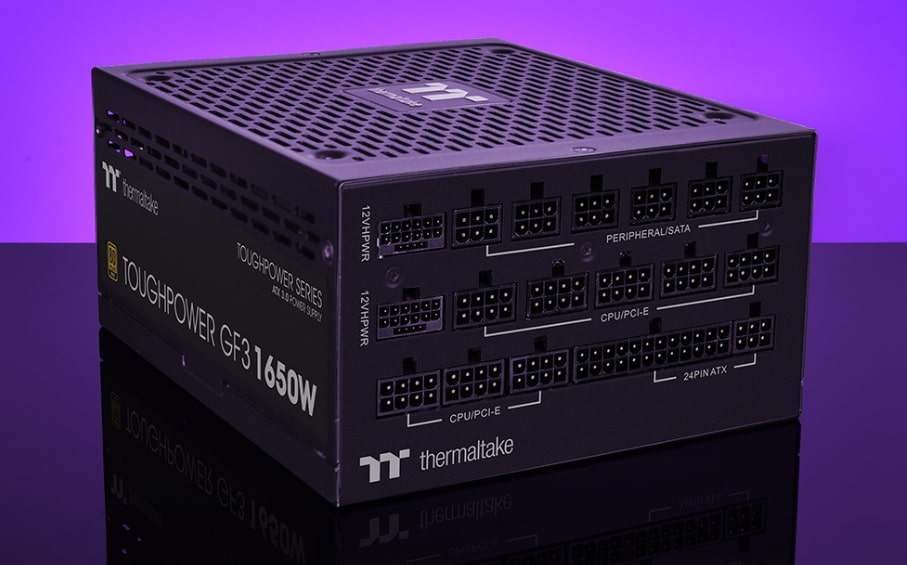
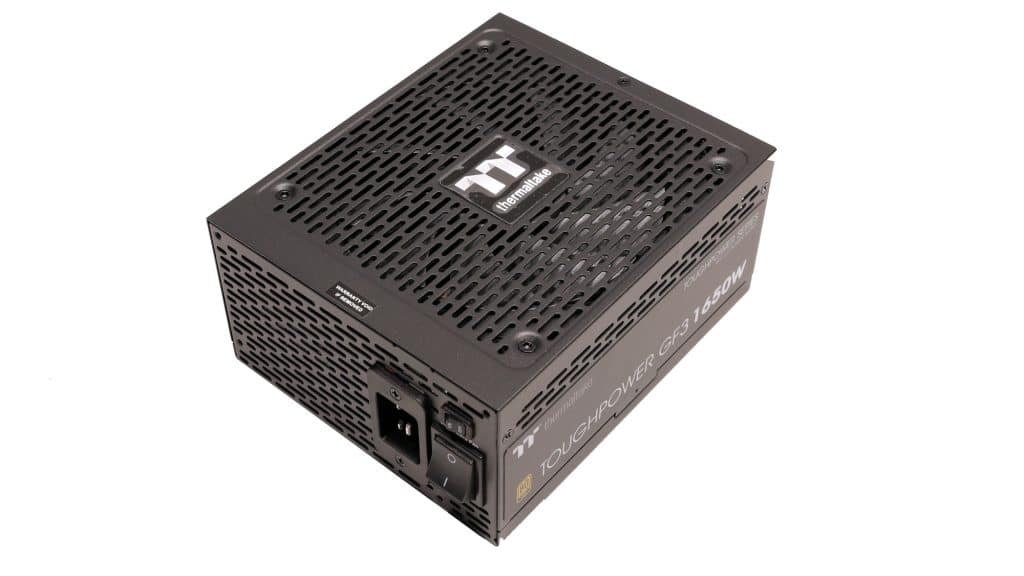
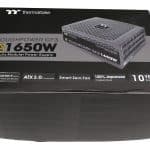
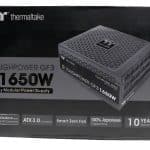

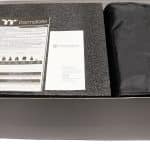
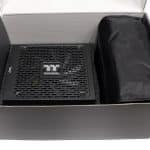



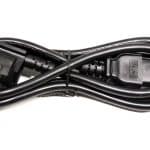
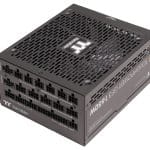

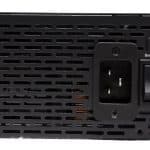
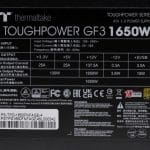
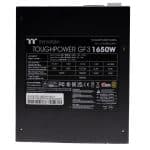
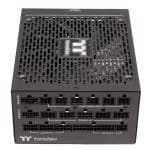

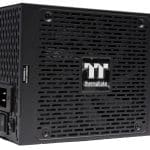
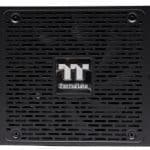
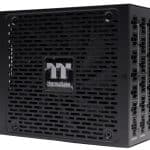
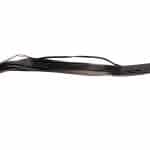


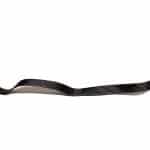

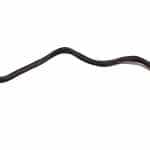






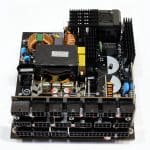
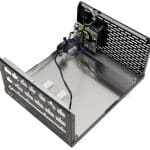
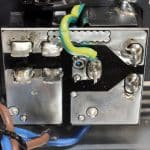
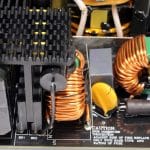
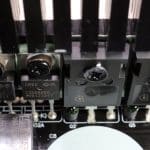


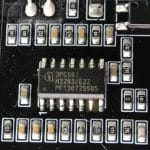
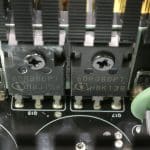


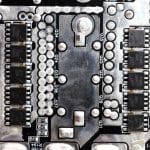
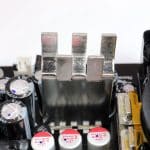
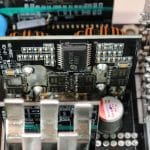
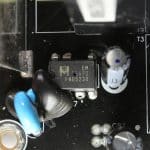
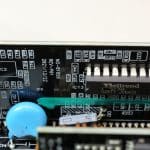

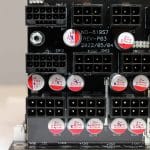
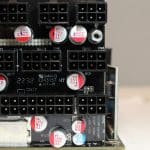
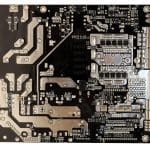
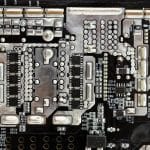
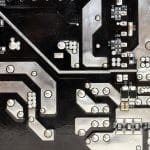
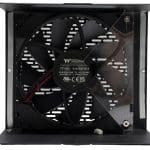
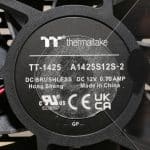
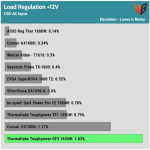
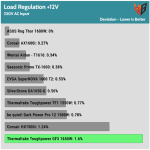
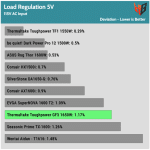
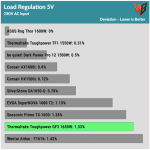
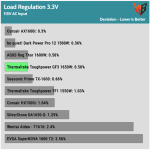
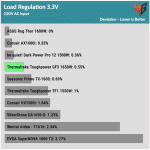
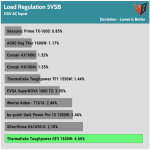
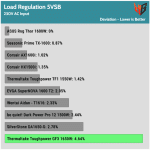

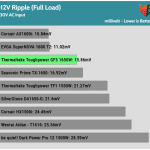
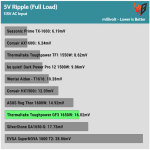

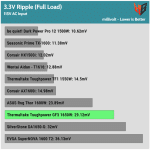
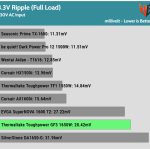
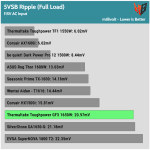
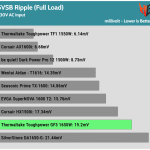

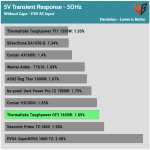
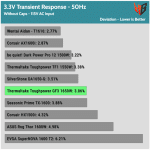
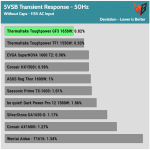
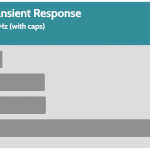

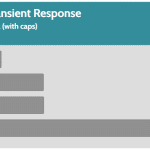
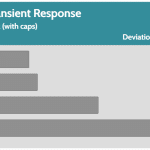
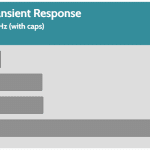
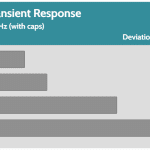
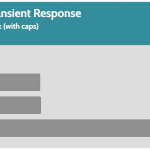
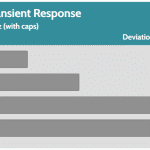
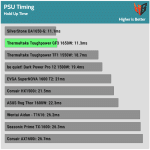
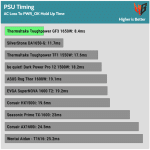
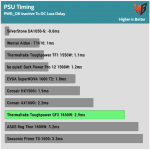


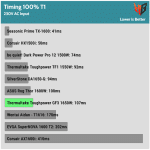

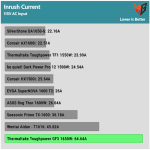
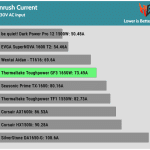
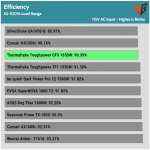
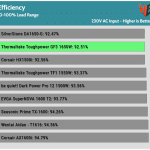
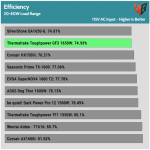
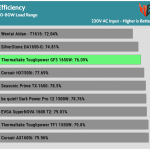
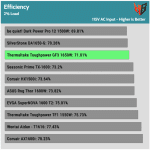
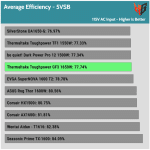

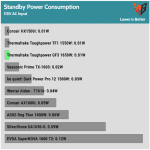

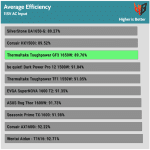
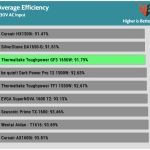

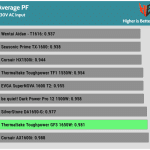

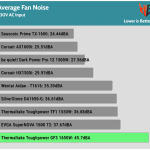
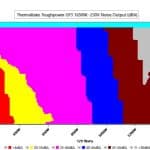
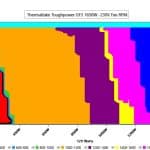





Hey chap,
Just wanted to say thanks for the hardwork,
Keep on going, I wont turn add block off but let me know if there is a donate link,
Much love
Thank you! No donate, no need —please give to a charity or feed stray animals instead.
BR
Aris
The unit does have OTP. According to the manual for the 1650W GF3:
“Protection temperature is 55°C to 75°C at 115v and full load.”
Source:
https://file.thermaltake.com/file/qig/TOUGHPOWER_GF3_1350_1650W_manual.pdf
We cannot verify that it has OTP, through our testing.
hello, when will we have a review of seasonic Vertex? What is the better option to wait for the new seasonics or buy a GF3?
I am still waiting for Vertex samples
Hello !
is it useful to change the fan for a noctua for example to compensate for the aggressive profile?
Changing the fan is not a straightforward matter in PSUs, because you need to run a full thermal analysis to estimate the cooling needs.